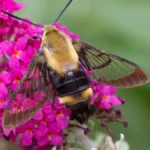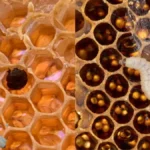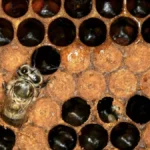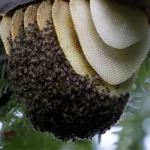In this article, we look at how to get rid of wax moths in beehives. Wax moth control in stored supers is important to ensure that your supers are not damaged. Problems with wax moths in your beehive are often a symptom of weak or stressed bees. Preventing wax moths in beehives and wax moth treatment are important basic beekeeping skills.
Types Of Wax Moths
There are two species of wax moth which are common. The Greater wax moth (Galleria mellonella) is the more common pest I have seen. The Lesser wax moth (Achroia grisella) can also be a pest but is less common generally.
Life Cycle Of Wax Moths
Both types of wax moth look about the same in the larval staves except the greater wax moth larvae grows to be larger, and makes a bigger mess. The female moth lays eggs in combs. If the combs have bee silk or pollen these combs are more attractive due to their higher protein content.
The larvae hatch and burrow around in the combs destroying the combs and leaving behind a tangled mess of silk and feces. The main visual difference between moths is the size – the greater wax moth larvae will grow larger than the lesser.
As the wax moth larvae proliferate, they spin a silky mess around the comb making it difficult for the bees to penetrate and remove the larvae.

Wax Moths In Beehives
The adult moth lurks in the bushes near hives and will sneak into the hive through the entrance or cracks in the supers and lids at night. They are sneaky and well dash past guards. In older, established hives the bees normally keep the entrance plugged with bees and propolis.
As conditions get colder, the bees can withdraw, or not have enough guards. The wax moths will sneak past and get into the corners and supers of the hive. Here they will lay eggs. The greater wax moth can produce so many larvae that the larvae can actually get into the brood nest and start pestering the bees. Under these conditions, the bees often abscond.
Preventing Wax Moths In Beehives
When we ask ourselves how to get rid of wax moths in beehives, the best answer is don’t let them get into the beehives. Strong hives which are full of bees will generally repel the moths. If the hive is given too much space, by adding too many supers, you can end up creating a shortage of bees to fill the hive, which can invite wax moth problems.
It is consequently important to add supers judiciously.
If you notice a wax moth outbreak, my normal response is to remove all the combs I can find that have moth damage and put them in the chicken cage. The chickens will normally peck all the wax moth larvae out within a few minutes. The nice thing with chickens is they turn a pest into eggs.
If you do not have chickens, you can freeze the combs. Freezing kills wax moth larvae, once killed, cut out the badly affected buts, scrape the rest of the comb with a bread knife to remove silk. If you need to store these combs until spring, try to keep them in the coldest possible area.
Wax Moth Control In Stored Supers
You can place cleaned combs in boxes and then put them in garbage bags or similar and place outside on freezing nights. This will sterilize and kill larvae that are around and then you can store the boxes, sealed until spring.
If you so wish, there are certain fumigants which are registered in different parts of the world and regions for fumigating supers. I personally am not a huge fan of any pesticides when used in beehives, because eventually with time people always find that these things leave residues.
Fumigants
For a long time, everybody swore that Para-dichlorobenzene was safe for treating wax moths. This product was registered for wax moth control in stored supers. This seems to have been withdrawn in many areas as it was found that PDB residues did indeed accumulate in the wax. Just looking at the name tells you it is bad.
Similarly, Phostoxin is legal for use in fumigating stored supers in many parts of the world. This product normally looks like a little grey pill. You put a few of these in bag of supers and seal.
The pills react and produce phosphine gas. Everything about this chemical is just bad. I would personally prefer to risk Wax moth damage than risk drowning in my own blood in my lungs by accidental exposure to this stuff.
Biocontrols
Various formulations exist globally which use Bacillus thuringiensis (BT) for the control of various insects. Depending on the strain of BT used, different types of insect pests can be controlled. It is very important to point out that you cannot use just any BT product – some of these will in fact kill your bees.
This formulation of BT uses a specific strain of BT which targets wax moth and is not harmful to your bees. These biocontrol products are very clever in many ways as they target pests in a way that poses little threat to the environment.
In some areas, ants can help to control wax moths. In areas where fire ants are present, these can help keep supers wax moth free. Local knowledge in these areas applies. I have seen places where beekeepers use fire ants, or various other aggressive ant species to keep wax moth under control.
In these methods, various super spacing systems allow the ants to roam around the hives, where they will eat anything that moves in the hives.
Preventing Wax Moths In Beehives
I have always maintained that wax moths are a symptom of bee management issues.
Keep wax moth populations in the area low (don’t leave combs degrading in a corner in your beehouse).
If you find a wax moth infestation, destroy it immediately by feeding it to your chickens, or burning the cocoons, or freezing them. Chickens are the best.
Keep bee colonies strong.
If you super your hives, check weekly, as one should during any honey flow. If you see wax moth damage, reduce super numbers.
Use queen excluders to keep your super comb free of bee silk. Wax moths need to eat something with protein in it in order to grow. Beeswax on its own is insufficient to nourish them. If bee brood has grown in the combs, the bee silk is a good source of protein for wax moths.
We hope that this article helped you understand how to get rid of wax moths in beehives. As you can see, it is up to all of us to work together to keep the numbers of these pests down. Share widely so we can spread the word and keep all of our beeswax moth free.
Read more about: Small Hive Beetle Larvae Vs Wax Moth Larvae

Dr. Garth A. Cambray is a Canadian/South African entrepreneur and beekeeper with 28 years of experience in apiculture and specializes in adding value to honey. His Ph.D. research developed a new advanced continuous fermentation method for making mead that has resulted in a number of companies globally being able to access markets for mead. His company, Makana Meadery, exports honey mead to the USA where it is available to discerning connoisseurs. He has also developed technologies to commercially manufacture organic honey vinegar in Zambia for export globally. He holds a few patents globally in the ethanol industry and believes in technology and knowledge transfer for human development and environmental sustainability. One of his proudest achievements is the fact that the wind farm he started at one of his old apiary sites has essentially made his hometown carbon neutral.






